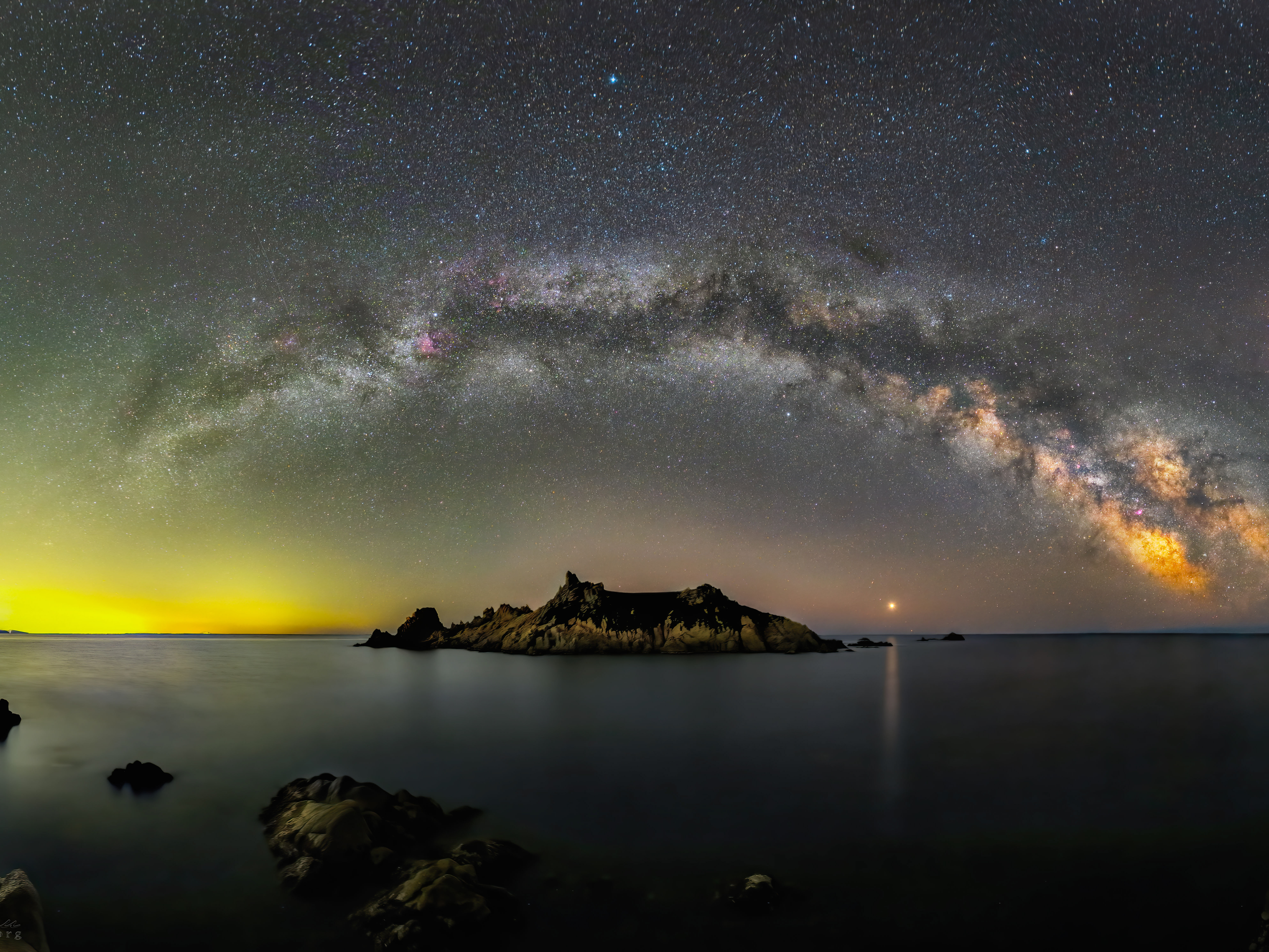Comet C/2023 A3 one week after Perigee, shot from Saint-Maximin-la Sainte-Baume, Var, France. I used different exposures for the highlights on the foreground, took advantage of the rising moon to have some details on the hills and stacked 60 exposures of the comet to bring all the details on the comet tail and anti-tail.
The Encounter with Comet C/2023 A3: Discovery, Trajectory and Capture Techniques
Intro : Comets fascinate with their rarity and fleeting brightness, crossing the sky and sometimes disappearing forever. Comet C/2023 A3, discovered at the start of 2023, offered astronomers and enthusiasts a precious opportunity to contemplate and photograph it. Let's take a look back at its history, its unique journey through the solar system, and some tips for capturing this celestial phenomenon.
1. Discovery: The Fruit of Precise and Collective Observations
C/2023 A3 was discovered in early January 2023 by the ATLAS observatory in South Africa, and Purple Mountain observatory in China, which were scanning the sky for new objects. These two sites are equipped with very powerful telescopes and specialized cameras, making it possible to identify faintly luminous objects. The discovery required several nights of observation and analysis, because a comet can easily be confused with a faint star. Once the characteristics of its orbit were confirmed, it appeared that this comet would be visible from Earth, a rare and significant event for professional and amateur astronomers.
2. An Amazing Journey: Perigee and Perihelion of C/2023 A3
Comet C/2023 A3 followed an elliptical orbit that brought it first to its perihelion, its closest point to the Sun, the 27th of September. I managed to capture it in the early morning sky a couple of days later over the Cap Lardier by the Mediterranean Sea. Following on, it reached its perigee, the closest point to Earth, on the 12th of October, providing a brighter, up-close view for observers, then in the evening sky. These dates are ideal for photography, as the comet is then the brightest. Unfortunately, some health issues prevented me from catching it when it was at its best visibility. I finally could try a week later but in pretty bad light pollution conditions. These two moments are also crucial for the observation, because the proximity of the Sun increases the luminosity of the comet : the intense heat of solar radiations sublimates its ices, creating a tail of gas and dust which accentuates its visibility. The tail is therefore pointing to the Sun opposite direction.
3. The Importance of Equipment and techniques: Using stacking and Equatorial Mount for Capturing Faint Objects
To photograph a comet like C/2023 A3, an equatorial mount plays an essential role. This type of mount is designed to follow the rotation of the Earth, allowing photographers to obtain long exposures without the comet becoming blurry. By adjusting the mount according to the celestial rotation axis, it compensates for the apparent movement of stars and celestial objects, stabilizing the image. This is essential for capturing the subtle details of faint objects like comets, especially when their brightness depends on variable and fleeting conditions. A good equatorial mount allows you to capture many details with longer exposure. With the help of stacking method, I could enhanced the structures of the comet in all their complexity with precision, revealing its shape and the 2 different tails : the big one going "upward" in the pictures and a much smaller one going downward, directed towards the sun. It could sound a bit counterintuituve, but the main tail is not due to the movement of the comet itself but rather to solar radiation heating the comet material.
Conclusion : A Memorable Encounter
I had the chance to photograph C/2023 A3 a few days before its perihelion and a week after its perigee, moments when it was still quite bright. These two important moments – perihelion, when it is closest to the Sun, and perigee, when it is closest to Earth – mark key points for observation and photography. Thanks to suitable equipment and favorable weather, this luminous journey could be captured, a unique memory of this celestial visitor.
**********
Technique and equipment :
📸 Canon 6D astromodified (Visible +H alpha)
📸 Samyang 135mm f2
🔭️ Tripod Leofoto LS-364C
🔭️ Star tracker Ioptron SkyGuider Pro
🖥️ APP - PS - PI (NoiseXt - StarXt) - LR
Comet C/2023 A3 2 days after Perihelion shot from Cavalaire-sur-mer, Var, France
📸 Canon 6D astromodified (Visible +H alpha)
📸 Samyang 135mm f2
🔭️ Tripod Leofoto LS-364C
🔭️ Star tracker Ioptron SkyGuider Pro
🖥️ APP - PS - PI (NoiseXt - StarXt) - LR
Comet Tsunchinshan-ATLAS on its way out of the System Solar, passing by the Milky Way core (as seen from Earth...)
Vertical panorama (Vertorama) stacked, tracked and blended with foreground (Ha data composited from an other night)
📷 Canon 6D Ha mod
📸 Sigma ART 40mm f/1.4
🔭️ tripod Leofoto LS-364C
🔎 Filter Ha 12nm Astronomik MAX FR
🖼️ Vertorama 4 panels in landscape orientation
🌄 FG untracked : 180s | f/2.5 | ISO 1000
🌌 SKY tracked RGB panel : 6x60s | f/2.5 | ISO 800
🌌 SKY tracked Ha panel : 5x180s | f/2.2 | ISO 6400
🖥️ APP - PS - PI (NoiseXt - StarXt) - LR
⚫ Bortle 3
📌 Cévennes National Park
📆 2024/11/1
🕐 18:44 PM UTC





